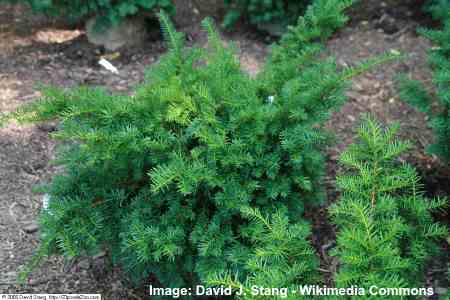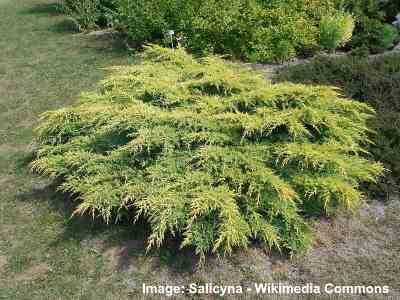37 Landscaping Bushes and Shrubs to Grow in Your Yard (with Pictures)
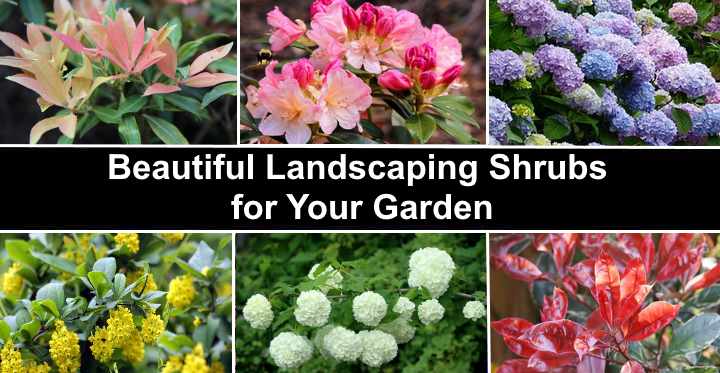
No garden landscape would be complete without different types of shrubs and bushes growing in it. There are flowering evergreen landscaping shrubs that provide year-long color and bloom in the spring, summer, and fall. Other types of perennial bushes are great low-growing border plants. You can also plant decorative bushes with various colors of leaves such as purple, red, and multicolored ones.
When choosing the best type of bush or decorative shrub for your yard, it’s important to look for low maintenance varieties. These types of easy to grow shrubs can transform your garden with minimal effort and care. As a result of this, you have more time to relax and enjoy the wonderful shrubs and bushes growing in your yard.
In this article, you will find landscaping bushes for any kind of large or small yard. You will find out the best types of shrubs to grow in full sun or partial shade. You will also discover some of the best low-growing evergreen bushes that provide great ground cover.
How to Choose Shrubs For the Landscape
Every garden landscape benefits from shrubs. When choosing landscaping bushes for your yard, think about the flower color, the amount of sunlight the shrub needs, and its mature size. Additionally, you’ll need to think about the USDA growing zone and the amount of maintenance you’re willing to do.
There are many types of attractive landscaping shrubs to choose from. Popular varieties of evergreen shrubs like junipers, spruces, and boxwoods are low-maintenance options, giving year-long greenery. Colorful flowering shrubs add beautiful colors and floral fragrances from spring until fall. Many dwarf or low-growing shrubs naturally have an attractive rounded mound without pruning.
Different Types of Bushes For Landscaping (with Pictures and Names)
Having attractive landscaping shrubs in your garden can provide color, privacy, beautiful blooms, and attract pollinators. Knowing how to choose the best bushes for your garden can be a challenge as there are literally thousands of different shrubs to choose from.
Read on to find some great low-maintenance shrubs for any kind of yard or garden.
Flowering Shrubs for Your Garden Landscape (With Pictures and Names) – Identification Guide
Hydrangeas

Beautiful hydrangea shrubs add focal point to any landscaped garden
Hydrangeas are a group of flowering decorative bushes that produce flowers in a range of colors from white to pink, purple, red and blue. There are over 70 species of hydrangeas that are large bushy flowering shrubs.
These low-maintenance landscaping bushes have large leaves that are good for ground cover. Blooms appear in early spring and continue flowering until early fall. Some types of hydrangea flowers are like large colorful aromatic balls, whereas others are clusters of flowers in a cone shape.
Planting hydrangeas in your garden also means that you have an abundance of cut flowers to add to your home décor during the summer.
Some notable hydrangea cultivars with beautiful flowers for your garden include:
- Hydrangea arborescens ‘Annabelle’ with its enormous white flowers
- Hydrangea paniculata ‘Magical Moonlight’ with green-white cone-shaped flowers
- Hydrangea ‘Double Dutch Edam’ that has beautiful star-shaped flowers
- Growing zones: 3 to 9 (however, check specific cultivars about your particular zone)
- Size: 3 to 10 ft. (1 m to 3 m)
- Conditions: Full sun to partial shade. Need rich moist soil to grow well.
- Difficulty: Easy for most gardeners.
Further reading: Hydrangea Care and Growing Guide.
Camellias

Camellia is a flowering shrub that has many hybrids and cultivars with white, pink and red flowers
Camellias are a type of evergreen flowering shrub that include over 3,000 different hybrids and cultivars. The beauty of camellia plants in your garden is that you get a wonderful array of colors throughout the summer.
If you are looking for a type of Camellia flower-producing bush for your garden, there are a number of small or dwarf cultivars to choose from. Usually, camellia shrubs are the first ones to bloom in your garden after winter.
You can also train camellia shrubs to grow against a wall to show beautiful floral displays in the summer.
Camellia bushes produce red, white, and pink flowers with single or double blooms, depending on the cultivar. Camellias are a good choice for your garden if you are looking for pink, white or red flowering shrubs.
Examples of Camellia flowering bushes for full to partial sun include:
- Camellia ‘Tricolor’ is a stunning hardy shrub with double blossoms that requires little care
- Camellia ‘Cinnamon Lady’ with beautiful white flowers and reddish-green leaves
- Camellia japonica ‘Don Mac’ that produces large red blooms which emerge from a dense pyramid-shaped bush
- Name: Camellia japonica or Camellia sasanqua
- Growing zones: 7 to 9
- Conditions: Full sun to partial sun. Grows in neutral to acidic soil that is well-drained.
- Difficulty: Easy to grow for glossy green foliage in your garden.
Viburnum
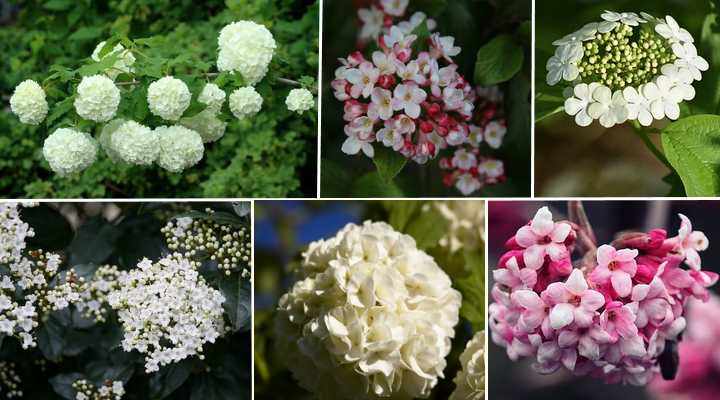
Viburnum flowers are white or pink and have different shapes, depending on the species
Viburnum is a compact, low-growing flowering landscape shrub with a rounded habit. The eye-catching feature of the bush is its creamy-white, five-petalled star-shaped flowers growing in showy clusters. Viburnum flowers are typically brilliant white or pinkish-white. The leathery oval leaves on Viburnum shrubs are deciduous or evergreen, depending on the climate.
Viburnum shrubs grow 3 to 5 ft. (1 – 1.5 m) tall and wide. Their landscaping appeal isn’t only the white flower clusters that bloom throughout the summer. The plant’s foliage turns orange, burgundy, or purple in the fall. Use Viburnum to decorate garden landscapes as a foundation planting, hedge, or border.
- Growing zones: 7 to 9
- Size: 3 to 5 ft. (1 – 1.5 m) tall and wide
- Conditions: Sun or partial shade
- Difficulty: Low-maintenance and pest-free
Further Reading: Types of Viburnum: Shrubs, Trees and Hedges.
Azalea (Rhododendron spp.)

Azalea is a type of flowering bush with many cultivars that will give stunning color to your garden
Plant azaleas in your garden if you want beautiful colorful flowers in spring. Azalea shrubs produce stunning blooms in various shades of pink, white, purple, red, and yellow.
Azaleas are a member of the rhododendron genus and there are hundreds of cultivars in the azalea species. These perennial flowering shrubs come in all shapes and sizes and it is easy to pick a type perfect for your landscaping needs. Some azalea cultivars are also extremely hardy and can survive harsh winters.
There are also many different types of Azalea flowers. Some are simple flowers with a single row of colorful wispy petals. Other types of flowers can be double flowers with contrasting colors, and other stunning varieties are double hose-in-hose flowers.
- Name: Rhododendron Tsutsusi (evergreen varieties) and Rhododendron Pentanthera (deciduous varieties).
- Growing zones: 3 to 9
- Size: 3 to 8 ft. (0.9 – 2.4 m)
- Conditions: Partial sun and any type of well-drained soil.
- Difficulty: Carefree and easy to grow.
Rose Bushes
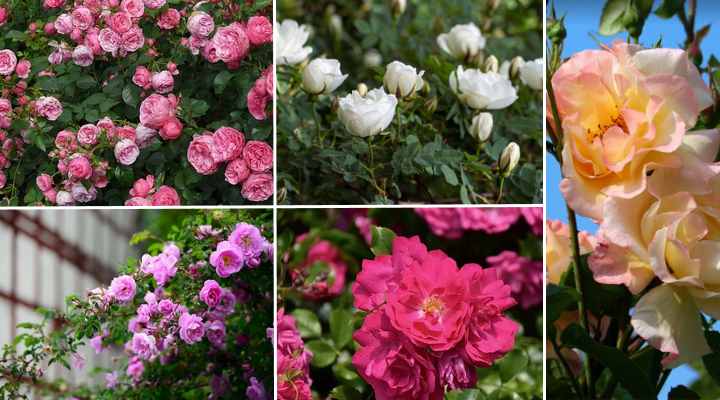
The are many stunning hybrids of rose shrubs in many color varieties
Rose bushes are beautiful landscaping shrubs for the front of the house known for their spectacular flowers, fragrant aromas, and winter hardiness. The best types of landscaping roses are climbing roses, miniature roses, floribunda, and shrub roses. Rose shrubs bloom all summer long with rosette flowers, and regular pruning encourages masses of scented flowers to appear.

Tree roses give stunning look to any garden landscape
To create a stunning landscape feature in your garden, you can plant a rose tree as a lawn or specimen tree. The rounded flowering canopy sits on top of a single slender stem. However, to cover a wall or fence with eye-catching rose bushes, climbing roses can grow up to 20 ft. (6 m).

Climbing roses
- Growing zones: 4 to 10, depending on the variety
- Size: 2 to 6 ft. (0.6 – 1.8 m) tall
- Conditions: Full sun
- Difficulty: Medium to hard, depending on the cultivar
Crape Myrtle (Lagerstroemia)
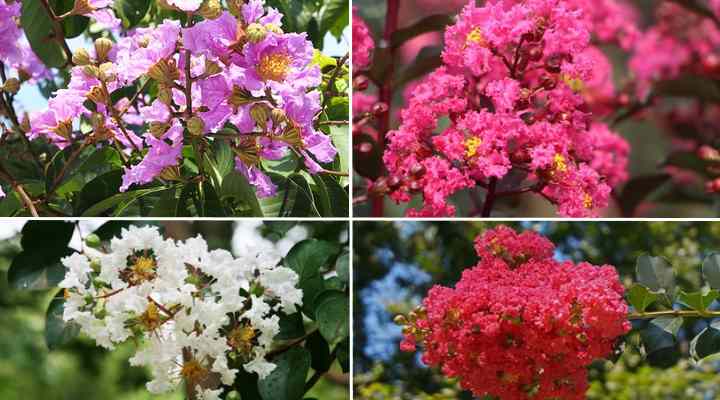
Crape myrtle flowers can be in shades of red, pink, purple and white
Crape myrtles are suitable landscaping shrubs for Florida and other subtropical climates. The compact, fast-growing woody shrubs produce showy white, pink, or red crinkly flowers at the start of summer and persist until the fall. Glossy dark green oval or lanceolate leaves turn yellow, orange, and maroon in the fall.
Crape myrtle flowers are spectacular in a hot summer landscape. The vibrant colors contrast with the shrub’s lush, glossy foliage. Landscape uses for crape myrtle plants include an informal hedge, screen, specimen shrub-like tree, or foundation planting.
- Growing zones: 7 to 10
- Size: 5 to 15 ft. (1.5 – 4.5 m), depending on the cultivar
- Conditions: Full sun to partial sun
- Difficulty: Easy to grow in medium moist, well-drained soil
Further reading: Crape Myrtles: Trees, Dwarf Plants and Shrubs.
Butterfly Bush (Buddleia davidii)
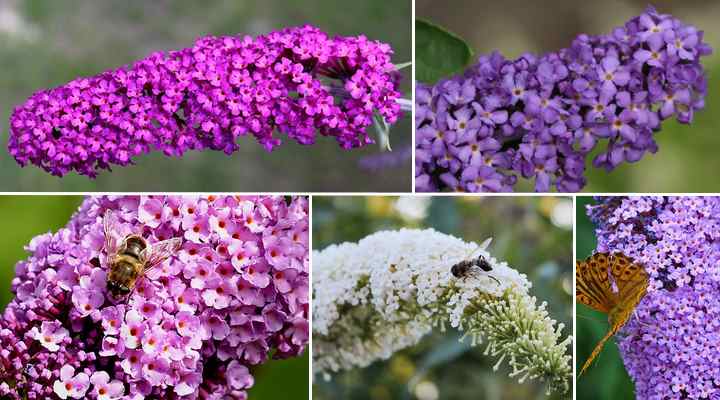
Butterfly bush flower colors are typically purple, pink and white, but can come in yellow and orange colors too
The butterfly bush is a vigorous, hardy shrub for landscaping, known for its arching dark purple cone-shaped flower clusters. The shrub is identified by its long, lanceolate leaves, honey-scented panicles, and light-brown fissured bark. The decorative flowering shrub grows 6 to 10 ft. (1.8 – 3 m) tall.
Butterfly bush is an excellent addition to gardens because the ornamental bush is easy to grow and attracts pollinators. Also called summer lilac, the landscaping shrub blooms all summer long with conical lilac flowers that fill landscapes with sweet scents. The beautiful perennial bushes are ideal for planting along borders, as a specimen shrub, or in a cottage garden.
- Growing zones: 5 to 10
- Size: 6 to 10 ft. (1.8 – 3 m) tall and wide
- Conditions: Full sun, at least six hours daily
- Difficulty: Drought-tolerant, prune back hard every spring
Further reading: Beautiful Types of Butterfly Bushes.
Fuchsia Shrubs

Fuchsia is a fast growing climber with attractive flowers in various shades of red, pink and purple
Fuchsia shrubs are identified by their characteristic red, pink and purple flowers dangling from arching stems like colorful earrings. The low-growing, purple flowering shrubs grow 1 to 2 ft. (0.3 – 0.6 m) tall. An outstanding feature of these miniature flowering shrubs is their long blooming time — from early summer until frost.
There are several fuchsia shrub cultivars with flowers in various colors. For example, the ‘Hawkshead’ has snow-white flowers, the ‘Alice Hoffman’ has red and white flowers, and the ‘Dollar Princess’ has showy pink and purple double flowers with broad, recurving petals.
- Growing zones: 6 to 11
- Size: 1 to 2 ft. (0.3 – 0.6 m)
- Conditions: Full sun to part shade
- Difficulty: Low maintenance
Virginia Sweetspire (Itea virginica)
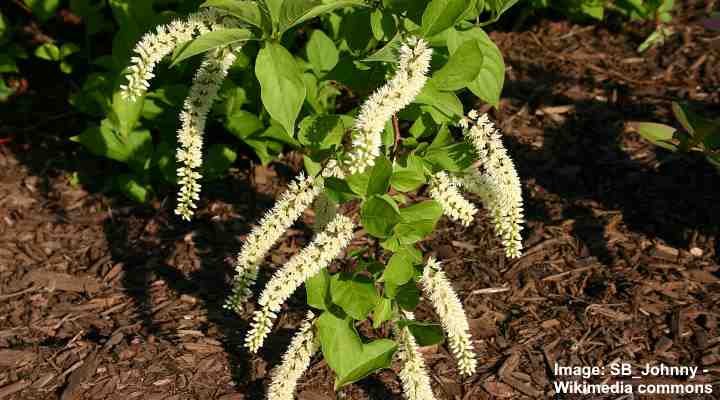
The low growing sweetspire shrub is great for landscaping compact spaces including shaded areas
Virginia sweetspire is a small to medium-sized low maintenance landscaping shrub. The shrub features creamy white bottlebrush flowers, rounded growth habit, and lush foliage of dark green oval leaves. Despite being a sun-loving plant, Virginia sweetspire also thrives in shaded conditions. The ornamental shrub grows between 3 and 10 ft. (1 – 3 m) tall and wide.
Virginia sweetspire is a popular deciduous shrub for landscaping. From late spring until fall, the bush is covered in arching cylindrical white flower clusters 4” to 6” (10 – 15 cm) long. The lush dark green leaves turn shades of reds and oranges in the fall.
- Growing zones: 5 to 10
- Size: 3 to 10 ft. (1 – 3 m) tall and wide
- Conditions: Full sun to complete shade
- Difficulty: Easy to grow
Bottlebrush Buckeye (Aesculus parviflora)
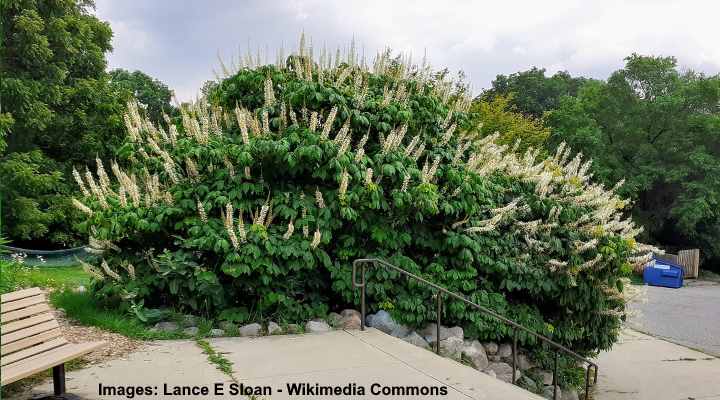
Bottlebrush buckeye is a hardy and low-maintenance shrub that produces a stunning floral display in spring and early summer
Like Virginia sweetspire, bottlebrush buckeye shrub is recognized by its cylindrical white blooms consisting of clusters of tiny flowers. Attractive features of the decorative shrub include palmately compound leaves 8” (20 cm) long, its open, spreading habit, and large brown pear-shaped seeds with a distinctive whitish scar (buck’s eye).
Bottlebrush buckeye thrives in shade and full sun. The suckering shrub’s palmate leaves with lanceolate leaflets turn from dark green to attractive shades of yellow in the fall. Use the shrub in a landscape for borders, background plants, or informal hedges.
- Growing zones: 4 to 8
- Size: 6 – 10 ft. (1.8 – 3 m)
- Conditions: Full sun to shade
- Difficulty: Easy to grow
Korean Barberry (Berberis koreana)
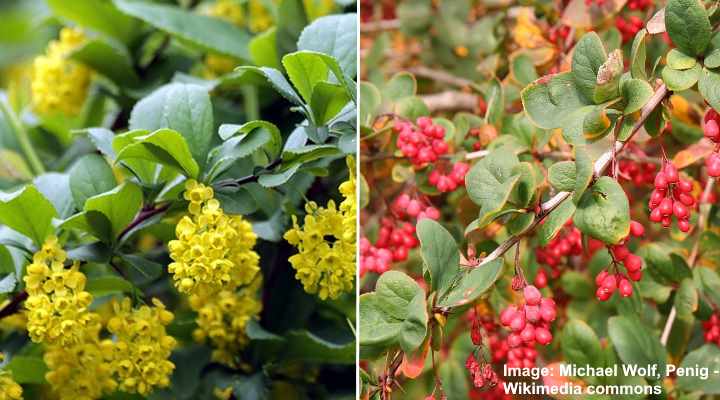
Korean barberry is a low maintenance semi-evergreen landscaping bush that provide year round interest
Korean barberry is a landscaping shrub that adds visual interest to a front or backyard. The hardy deciduous shrub is known for its pretty clusters of yellow flowers that hang from the stems in spring and bright red berries in fall and winter. Small obovate serrated green leaves turn maroon and deep purple in the fall.
Korean barberry is an easy-grow ornamental shrub that tolerates drought and is deer resistant. In addition, you can grow the garden shrub as a screen, hedge, wind-resistant barrier, or foundation planting.
- Growing zones: 3 to 7
- Size: 4 – 6 ft. (1.2 – 1.8 m)
- Conditions: Full sun to partial sun
- Difficulty: Easy
Hummingbird Summersweet (Clethra alnifolia)
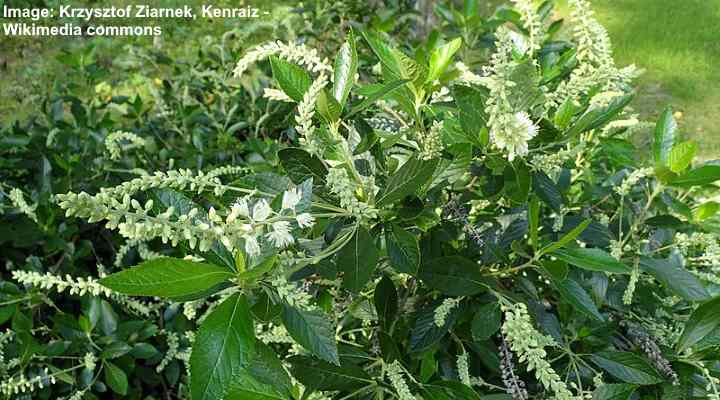
Clethra alnifolia ‘Hummingbird’ is a compact white flowering shrub that is suitable for both sunny and shady locations
Also called sweet pepperbush, summersweet is a splendid clumping landscape shrub with spikes of fragrant white flowers, lush lance-shaped leaves, and attractive compact growth. Summersweet is a popular shrub for landscaping in a shaded garden, thriving in deep shade. The shrub grows 5 to 10 ft. (1.5 – 3 m) tall and up to 6 ft. (1.8 m) wide.
Summersweet blooms in mid to late summer, and the dainty white flowers attract pollinators. In addition, beautiful golden yellow foliage graces the rounded deciduous shrub in the fall. The robust, hardy shrub tolerates various soil types and will thrive in wet soil.
- Growing zones: 3 to 9
- Size: 5 to 10 ft. (1.5 – 3 m) high and 4 to 6 ft. (1.2 – 1.8 m) wide
- Conditions: Full sun or deep shade
- Difficulty: Easy to grow if it gets plenty of water
Dwarf Blooming Lilac (Syringa meyeri ‘Palibin’)

Syringa meyeri ‘Palibin’ is a dwarf Korean lilac bush for small gardens due to its compact growth
The dwarf Korean lilac shrub is ideal for landscaping because it only grows 4 or 5 ft. (1.2 – 1. 5m) tall. The compact, low-spreading rounded shrub has light lilac-pink conical flower clusters and dark green leaves that turn reddish-bronze in the fall. The Meyer lilac shrub is suited to landscaping in urban environments.
The slow-growing dwarf Korean lilac is an exceptionally versatile low maintenance landscaping shrub as it’s tolerant of drought, heat, and poor soils.
- Growing zones: 3 to 7
- Size: 4 to 5 ft. (1.2 – 1.5 m)
- Conditions: Full sun
- Difficulty: Low-maintenance, drought-tolerant
Related: Lilac Bush: Facts, How to Grow It, Care Tips and More
Rose of Sharon (Hibiscus syriacus)
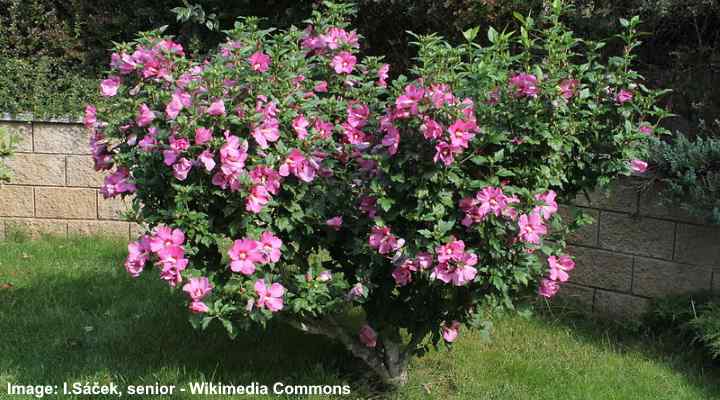
Although it is a shrub, the rose of Sharon looks like a small bushy tree which is why it’s also called the Althea tree
The rose of Sharon (Hibiscus syriacus) is a type of flowering shrub or small tree that produces beautiful red, white, pink, light blue, or lilac flowers.
Despite its name, this deciduous shrub isn’t a rose but a member of the mallow family Malvaceae. Other popular names for the rose of Sharon include Chinese hibiscus, Althea tree, Korean rose, or rose mallow.
- Name: Rose of Sharon (Hibiscus syriacus).
- Growing zones: 5 to 8
- Size: 8 to 12 ft. (2.4 – 3.6 m)
- Conditions: Full sun to part shade and any type of well-drained soil.
- Difficulty: Carefree and easy to grow.
Common Ninebark (Physocarpus opulifolius)
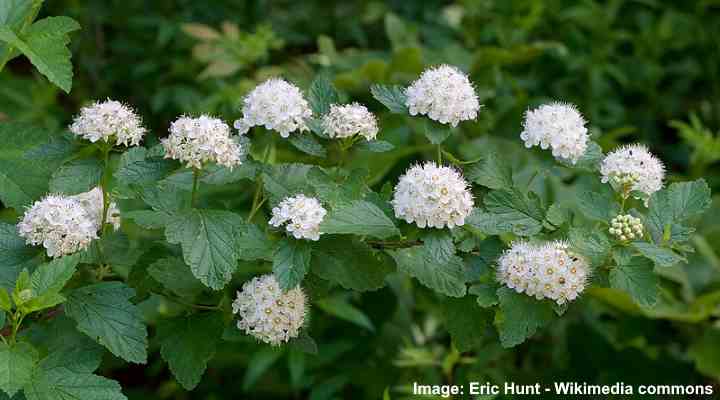
The hardy ninebark shrub is great as a foundation shrub or flowering hedge
Common ninebark is a sun-loving, fast-growing bushy landscape shrub. The deciduous plant has upward, spreading growth with arching stems, yellowish-green foliage, dark brown exfoliating bark, and pinkish-white flowers. After flowering, drooping clusters of red fruit appear in the fall. Common ninebark grows 5 to 8 ft. (1.5 – 2.5 m) tall and up to 10 ft. (3 m) wide.
Common ninebark shrubs are known for their hardiness and resistance to pests. You can plant the shrub as a specimen bush, deciduous hedge, or screen in cold or temperate regions. However, the shrub may suffer in hot temperatures if it doesn’t get sufficient watering.
- Growing zones: 2 to 8
- Size: 5 to 8 ft. (1.5 – 2.5 m) tall and up to 6 to 10 ft. (1.6 – 3 m) wide
- Conditions: Part sun, part shade
- Difficulty: Medium maintenance required
Purple Ninebark (Physocarpus opulifolius ‘Monlo’)
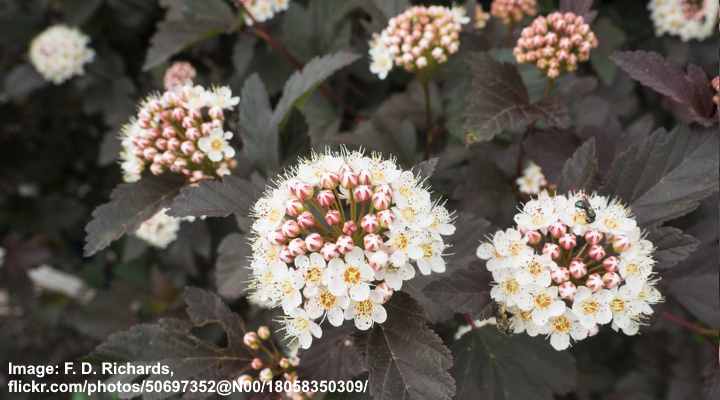
Diabolo ninebark has attractive purple leaves with light colored flowers
Purple ninebark is a large deciduous flowering shrub with dark purple leaves that belongs to the rose family. It is a cultivar of Physocarpus opulifolius (common ninebark) that has a green foliage.
Purple ninebark is a fast growing shrub with white or light pink clustering flowers that bloom in late-spring or early-summer.
Other names for Purple ninebark shrub include “Diabolo ninebarks” or “purple-leafed ninebarks”.
- Growing zones: 3 to 7
- Size: 10 ft. tall and a similar spread (3 m)
- Conditions: Full sun to partial shade. Requires well-drained soil that is kept moist.
- Difficulty: Easy to grow.
Honeysuckle Shrubs
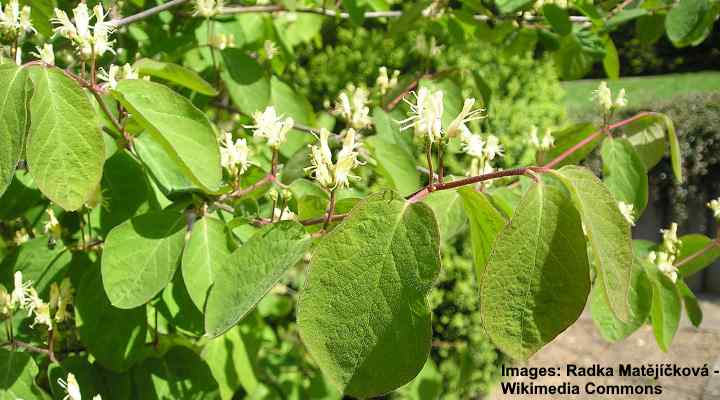
Lonicera xylosteum (in the picture) is a low growing shrub with fragrant flowers
A few honeysuckle shrubs are flowering dwarf plants with compact growth, famous for their heavily scented flowers. The cold-hardy shrubs grow between 3 and 6 ft. (1 – 1.8 m) tall. They have characteristic fragrant pale yellow or pink flowers, each with four spindly petals. After blooming, honeysuckle shrubs produce clusters of glossy red, pink, or orange berries.
The ‘Blue Moon’ and ‘Borealis’ honeyberry or blue honeysuckle are cold-hardy deciduous shrubs that grow up to 3 ft. (1 m) tall. The blue honeysuckle shrub has yellowish-white flowers that develop into edible blue, blueberry-like fruits.
The honeysuckle species Lonicera xylosteum is a type of compact dwarf honeysuckle that more resembles climbing perennial honeysuckles with their scented flowers. Unlike blue honeysuckle, you shouldn’t eat the fruits of regular honeysuckle plants.
- Growing zones: 4 to 9
- Size: 3 to 6 ft. (1 – 1.8 m) tall, depending on the species
- Conditions: Full to partial sun
- Difficulty: Medium maintenance to prevent the non-native shrubs from becoming invasive
Mountain Laurel (Kalmia latifolia)
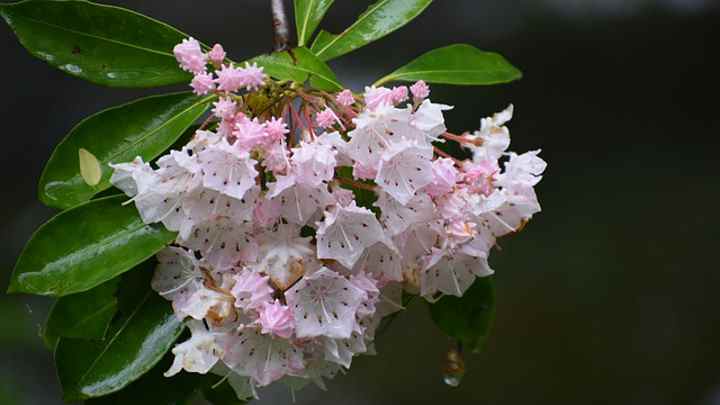
Mountain laurel flowering bushes can tolerate some shade in the garden
Mountain laurel is a flowering shrub suitable for landscaping in shaded gardens. The evergreen foliage consists of leathery, glossy green leaves, contrasting with large clusters of pale pink hexagonal blooms. The long-blooming flowers persist through summer, giving way to brown fruits. Mountain laurel grows 5 to 15 ft. (1.5 – 4.5 m) tall.
Also called spoonwood or ivy bush, mountain laurel is ideal as a specimen plant in a landscape. However, you can also grow it as a shrub border or a cottage garden. Deadheading the flowers can extend the blooming time.
- Growing zones: 4 to 9
- Size: 5 to 15 ft. (1.5 – 4.5 m) tall and wide
- Conditions: Partial shade
- Difficulty: Easy
Potentilla Shrubs (Potentilla fruticosa)

Potentilla fruticosa includes different cultivars with flowers ranging from white to yellow, orange and pink,
Dwarf potentilla shrubs are ideal for adding green foliage and brightly-colored flowers to a garden landscape. The mounding, low-growing shrub grows 3 ft. (1 m) tall and blooms with pink, orange, red, white, and yellow flowers throughout the summer. Other names include shrubby cinquefoil and golden hardhack.
When blooming all summer long, potentilla shrubs are covered in masses of flowers. The incredibly robust plant withstands drought and freezing temperatures, and it’s one of the easiest landscaping shrubs to grow. Plant potentilla in full sun as an informal hedge, specimen bush, or along borders.
- Growing zones: 3 to 7
- Size: 2 to 4 ft. (0.6- 1.2 m) tall and 3 to 5 ft. (1 – 1.5 m) wide
- Conditions: Full sun to partial shade.
- Difficulty: Extremely easy
Types of Decorative Evergreen Shrubs to Grow in Your Yard (With Pictures and Names) – Identification Guide
Shrubs that are green all year round are essential for a beautiful garden landscape.
Winter Creeper (Euonymus fortunei)

The colorful foliage of small evergreen euonymus shrubs add an ornamental element to any garden. This picture shows the compact cultivars: ‘Emerald ‘n’ Gold’, ‘Emerald Gaiety’ and ‘Moonshadow’
Winter Creeper is an evergreen versatile landscaping shrub with low-growth habit, small variegated ovate leaves and dark brown-gray bark. The Winter Creeper is an easy-care compact shrub to grow in your front of house that provides foliage and greenery all year long.
Hardy low maintenance evergreen landscaping shrubs such as the Winter Creeper are ideal for planting along borders, providing ground cover, or in containers. This evergreen shrub can also climb and decorate trellises or garden walls, grown as foundation plants, or you can plant the shrub en masse as a low hedge.
Winter creeper cultivars such as the ‘Blonde Beauty’ also have multicolored leaves. These can give your yard attractive yellow and green colors throughout the winter. You can also plant this type of perennial bush in full sun and in shady areas.
Other good Winter Creeper cultivars include the delightful ‘Emerald Gaiety,’ ‘Emerald ‘n’ Gold,’ ‘Fortune’s Spindle,’ and ‘Emerald Surprise.’
- Name: Other names for the landscaping shrub include spreading euonymus, Japanese euonymus, or climbing euonymus.
- Growing zones: 5 to 9
- Size: Up to 24” (60 cm) tall and a spread of 40” (100 cm)
- Conditions: Grows well in full sun, partial shade, or full shade. Thrives in well-drained soil but also tolerates poor soil.
- Difficulty: Very easy.
European Box Plant (Buxus)
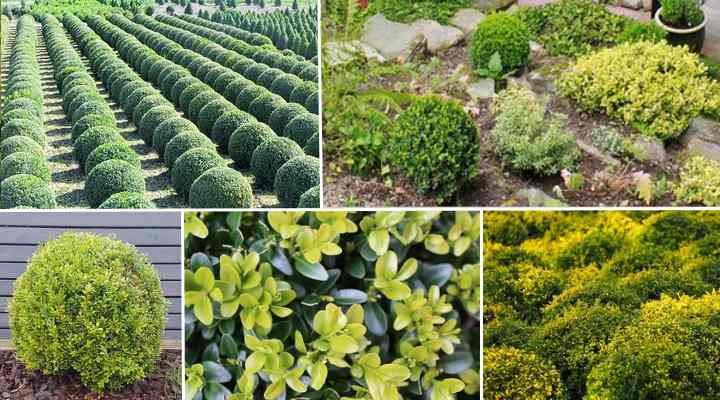
Box plants can create low growing formal hedges or tall privacy hedges, depending on the cultivar
Boxwood plants are great evergreen bushes for your garden that you can easily shape or prune to your needs. The boxwood shrub is an excellent landscaping plant for the front of house.
The European Box plants are generally slow-growing evergreen shrubs that have thick green leaves. Depending on the cultivar, you can also get variegated varieties that have yellow and green leaves. These are also good types of medium-sized compact shrubs to create privacy hedges.
If you are looking for a small cultivar of the boxwood variety, choose the Buxus microphylla ‘Sprinter.’ This grows well in zones 5-8 and only reaches a height of 3 ft. (120 cm).
- Growing zones: 5 to 8
- Size: Cultivars range from 3 ft. (0.9 m) to 30 ft. (9 m)
- Conditions: Partial shade. Grows in sandy to heavy clay soils that drain well.
- Difficulty: Need some pruning in the summer, but generally easy to grow.
Japanese Laurel (Aucuba japonica)
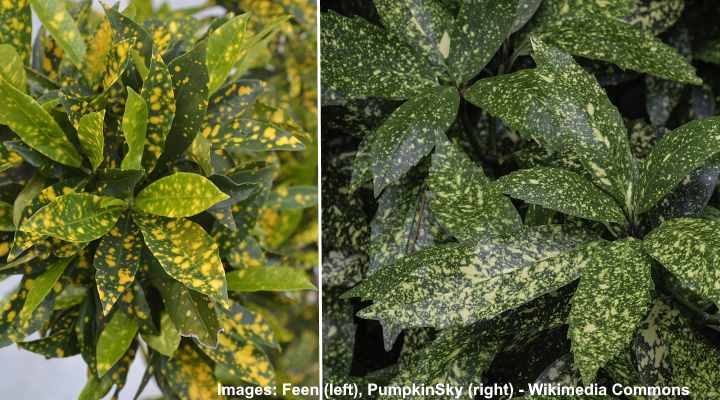
The spotted laurel is a great type of shrub for partial sun and shady areas. It’s also an excellent evergreen hedge. On the right: “Gold Dust” cultivar
The Japanese Laurel is a wonderful landscaping shrub that has long, broad evergreen leaves. This low maintenance bush for front yards or back yards is also called ‘Spotted Laurel’ or ‘Gold Dust’ plant.
If you need a good hardy shrub for shady areas of your garden, then Japanese laurel cultivars are a great choice. Many have large glossy leaves, and some cultivars are variegated – meaning their leaves have 2 or 3 colors.
Many types of Japanese laurels have small insignificant flowers during the summertime. However, the appearance of red berries in the fall gives your garden some bright colors.
Some outstanding Japanese Laurel cultivars include ‘Crotonifolia’ shrub with bright yellow leaves and green speckles, ‘Golden King’ that has green leaves with yellow blotching, or the ‘Picturata’ with glossy green leaves and a yellow center.
- Growing zones: 6 to 10
- Size: Between 6 and 10 ft. (1.8 – 3 m) tall and a spread of 5 to 9 ft. (1.5 – 2.7 m)
- Conditions: Partial sun and shade. Grows well in most types of soil and the soil should be dry or moist.
- Difficulty: Low maintenance and easy to care for.
Fatsia Japonica
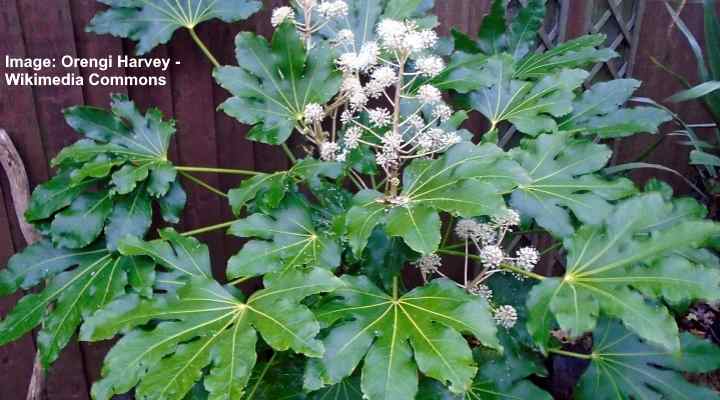
Fatsia japonica is one of the best evergreen flowering shrubs for shade
The Fatsia japonica is a low-maintenance evergreen shrub and is one of the best shrubs if you want one with large leaves.
The Fatsia japonica is a hardy, robust type of shrub that is fast growing. The large shiny leaves on the plant can grow up to 18” (45 cm) wide and can easily provide good ground coverage. During the summer, you can expect clusters of small white flowers to grace this majestic large-leafed bush.
For some additional color in your garden, you could also plant the Fatsia japonica ‘Variegata.’ This hardy shrub has blotches of yellows and whites decorating the dark-green leaves.
- Growing zones: 7 to 10
- Size: 5 to 8 ft. (1.5 – 2.4 m) tall
- Conditions: Partial shade. Grows well in a variety of different soils.
- Difficulty: Easy to grow and regular pruning will help manage the height.
Photinias
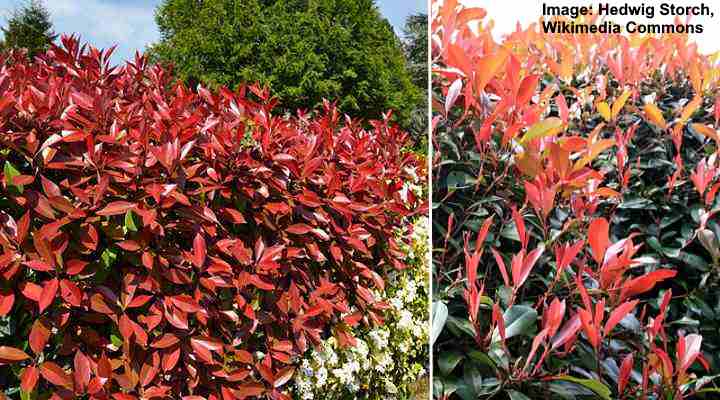
Photinia ‘Red Robin’ (Photinia x fraseri ‘Red Robin’) is a popular type of evergreen hedge shrub with new red leaves that gradually turn green as they mature. It’s an excellent evergreen privacy hedge
Photinia is a group of shrubs and small trees that are delightful ornamental plants for their striking foliage colors.
Many Photinia cultivars grow well in temperate climates and stay green throughout the year. One of the reasons for planting these popular shrubs is for their red leaves that appear in spring and summer. These large garden shrubs can also make attractive hedges for year-long privacy.
For example, one of the most popular types of Photinia is the red shrub called Red Tip Photinia (Photinia fraseri). New leaves appear red before gradually turning green as they mature.
Other notable Photinia shrub cultivars with red leaves are ‘Red Robin,’ ‘Pink Marble,’ and ‘Scarlet Blaze.’
- Growing zones: 7 to 11
- Size: Depending on the cultivar, up to 4 ft. (3 m) tall and a spread of the same size.
- Conditions: Full sun or partial shade. Grows in most types of soil; however, for vibrant red bushes, you need nutrient-rich soil.
- Difficulty: Easy to grow, but may need regular pruning to control height.
Daphne Odora
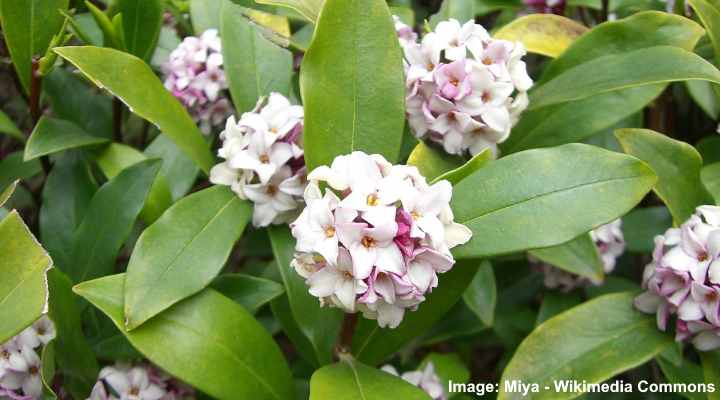
Daphne odora is a type of evergreen bush with fragrant blossoms
Daphne Odora is another type of evergreen flowering bush that grows well in yards without much maintenance.
This medium-sized shrub produces fragrant purple and pink blossoms in late winter and early spring. The dark-green leaves often have yellow edging which gives the shrub a very colorful look all year long.
The Gold-Edged Winter Daphne (D. odora ‘Aureomarginata’) is the hardiest of the ‘Daphne’ shrubs and has gold-edged leaves.
This evergreen shrub may not be suitable for all gardens as its leaves are poisonous to humans and animals if eaten.
- Growing zones: 7 to 9
- Size: 3 to 6 ft. (1 – 1.8 m)
- Conditions: Full sun or partial shade. Loamy or clay soils that drain well.
- Difficulty: Quite difficult and the plants only last up to 10 years.
Japanese Pieris (Pieris japonica)
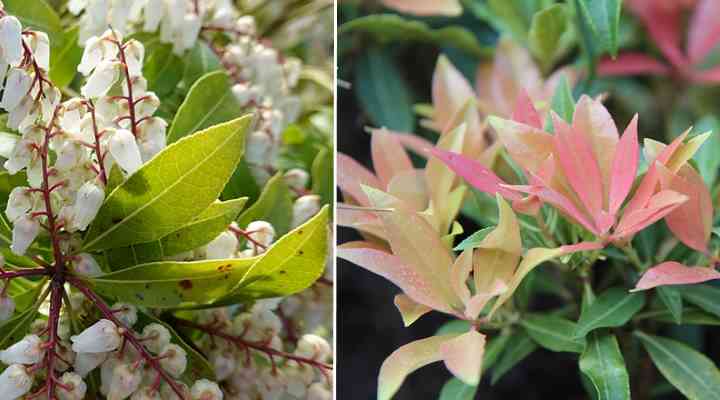
The pink-red young leaves of Japanese pieris turn green when they mature
Japanese pieris is an evergreen landscaping shrub with pinkish-white urn-shaped flowers growing in finger-like clusters. Attractive features of the Japanese pieris include emerging red foliage, leathery, glossy green oblong leaves, and dark brown bark. The large landscaping shrub grows 9 to 13 ft. (2.7 – 4 m) tall and up to 8 ft. (2.4 m) wide.
Also called Japanese andromeda, the beautiful shrub thrives in full sunlight and partial shade. You can grow this sizable flowering landscaping shrub as a foundation planting, specimen bush, or evergreen hedge. In spring and summer, the bush fills landscapes with bright white and pink blossoms resembling lily-of-the-valley flowers.
- Growing zones: 4 to 8
- Size: 9 to 13 ft. (2.7 – 4 m) tall and 4 to 8 ft. (1.2 – 2.4 m) wide
- Conditions: Full sun to partial shade
- Difficulty: Easy
Low-Growing Shrubs and Bushes for Your Yard (With Pictures and Names)
Other types of no-maintenance shrubs that are excellent for evergreen foliage are varieties of juniper, cypress, and spruce. Cultivars of these coniferous trees/shrubs are excellent for low-growing landscaping solutions that don’t require any maintenance.
Siberian Carpet Cypress (Microbiota decussata)
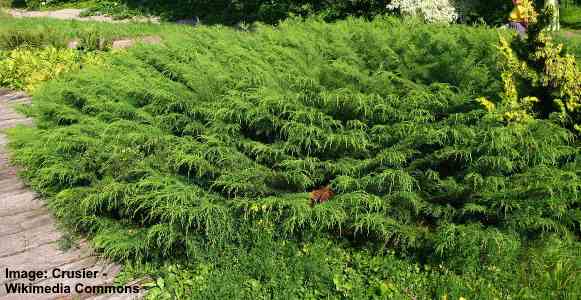
The Siberian Carpet Cypress is a type of low growing spreading evergreen shrub that is good as a ground cover bush
As its name suggests, the Siberian carpet cypress is a low-growing evergreen shrub that grows well in full sun as well as in cool shady areas of your garden.
Once planted, this Siberian coniferous shrub spreads out along the ground producing a thick green carpet. This spreading shrub is also drought-resistant and can withstand harsh cold winters.
- Growing zones: 2 to 7
- Size: 40” (1 m) high and a spread of up to 40” (1 m)
- Conditions: Full sun. Prefers moist soil that drains well.
- Difficulty: Easy to grow with zero maintenance.
Juniper ‘Blue Star’ (Juniperus squamata ‘Blue Star’)
Juniper shrubs such as the ‘Blue Star’ are excellent dwarf varieties of this evergreen shrub that grow well in most conditions.
The Juniper ‘Blue Star’ cultivar provides good low-level ground cover without requiring any care. The hardy shrub is slow-growing and will give silvery carpeting to your garden.
- Growing zones: 4 to 8
- Size: 24” to 36” (60 – 90 cm) and a spread of 3 to 4 ft. (90 – 120 cm)
- Conditions: Full sun as it doesn’t grow in the shade. Any type of soil as long as it drains well.
- Difficulty: Very easy requires no maintenance.
Yew ‘Densiformis’ (Taxus media ‘Densiformis’)
The dwarf evergreen spreading yew plant is an excellent choice of low growing shrub for front of house. The branches are covered in soft needles that provide excellent ground coverage.
If you need some height from your coniferous bush, then dwarf Yew varieties such as this can grow to a height of 3 ft. The evergreen leaves also spread out well to create an attractive bushy yew shrub in shady conditions.
- Growing zones: 4 to 7
- Size: 3 to 4 ft. (0.9 – 1.2 m) and a spread of 4 to 6 ft. (1.2 – 1.8 m)
- Conditions: Full sun to partial shade. Grows in any type of soil from light sandy soil to heavy clay soil that is well-drained.
- Difficulty: Easy with no maintenance.
Dwarf Norway Spruce (Picea abies ‘Little Gem’)
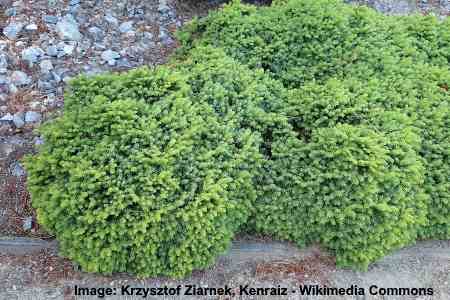
The Dwarf Norway Spruce is an evergreen shrub with flattened round dense foliage – it’s an excellent shrub for front of house.
If you are looking for a small low maintenance shrubby conifer for your garden, then dwarf varieties of spruce trees are great choices.
For example, the Norway spruce cultivar ‘Little Gem’ grows to just under a foot (30 cm) and creates a compact cushion-like bush. You can plant this small shrub in gardens with limited space. Or, you can plant a few shrubs together for a good ground coverage that doesn’t need maintaining.
- Growing zones: 3 to 8
- Size: 10” to 12” (25 – 30 cm) and a spread of the same size
- Conditions: Full to partial sun. Grows in neutral to acidic soil and prefers moist or damp soil conditions.
- Difficulty: Easy.
Juniper ‘Sea Green’ (Juniperus pfitzeriana ‘Sea Green’) and Juniper ‘Mathot’
One type of medium-sized coniferous shrub that is easy to grow is a type of Juniper bush called the ‘Sea Green.’ This is also called the Chinese Juniper. Another similar cultivar with more yellowy-green foliage is called Juniper Mathot’.
Both junipers are decorative evergreen shrubs for your garden. The reason for this is that they have arching branches that give the shrub a cascading effect. In the summer, the soft foliage of ‘Sea Green’ cultivar is a minty-green color that gradually darkens as it gets colder.
This low maintenance plant is a good choice where you need medium height ground cover or if you want to create an attractive hedge.
- Growing zones: 4 to 9
- Size: 4 to 6 ft. (1.2 – 1.8 m) and a spread of 6 to 8 ft. (1.8 – 2.4 m)
- Conditions: Full to partial sun and survives well in dry, sandy soil.
- Difficulty: Easy with little to no maintenance.
Further reading: Dwarf Conifers: Dwarf Pine, Spruce, Cypress, Juniper & Yew.
Other Decorative Shrubs to Grow in Your Yard (With Pictures and Names)
Other landscaping shrubs have other attractive features such as colorful foliage or red/purple berries.
Japanese Barberry (Berberis thunbergii)
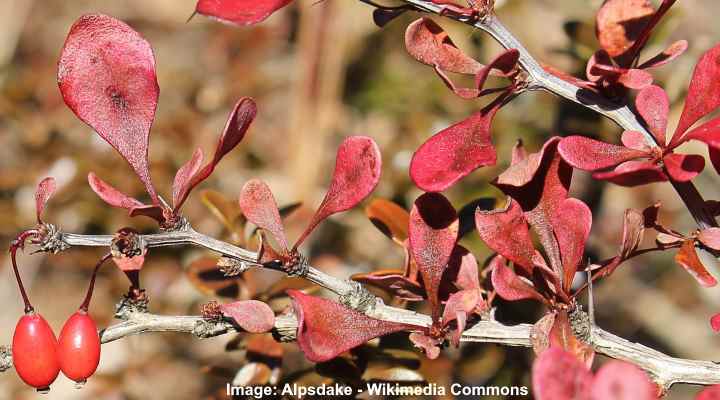
Japanese barberry is a prickly bush with colorful leaves that can be grown as security hedge
Japanese barberry is a thorny landscaping shrub that tolerates heat and drought. Most Japanese barberry shrubs are known for their bright to deep red small oval leaves, scented pale yellow spring flowers, and bright red berries in the fall. After the leaves drop, the erect spiny stems are visible.
Also called Thunberg’s barberry, the Japanese barberry has a rounded growth habit. Its prickly, stiff stems make the shrub ideal as a privacy hedge or barrier for protection. You can also grow the shrub massed in borders and beds or as a single specimen plant.
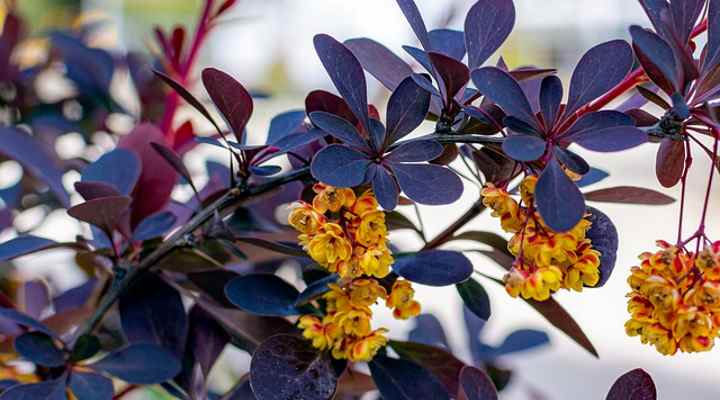
The purple Japanese barberry (Berberis thunbergii f. atropurpurea) is a purple-leaved thorny shrub
- Growing zones: 4 to 8
- Size: 3 to 6 ft. (1 – 1.8 m) and 4 to 7 ft. (1.2 – 2.1 m) wide
- Conditions: Full sun to partial shade
- Difficulty: Medium to high maintenance
Red Twig Dogwood (Cornus alba)

Red twig dogwood shrubs add beautiful color to your garden in winter.
If you are looking for stunning shrubs with red bark and white flowers for landscaping, then some varieties of red twig dogwood are excellent choices.
Shrubs such as the Siberian red twig dogwood have red-barked stems that become striking deep red in the fall and winter. This type of red shrub can look stunning when there is little color in your garden apart from evergreen plants. You can transform your garden with shades of orange, gold, and red.
During summertime, Dogwood cultivars have light green leaves. Certain cultivars such as the ‘Elegantissima’ have delicate clusters of white flowers that provide some contrast to this flowering shrub.
- Growing zones: Hardy down to zone 3
- Size: 10 ft. (3 m) tall and a spread of up to 6 ft. (2 m)
- Conditions: Plant in sunny spots to get the deepest red colors on this bush. Grows well in most soil conditions.
- Difficulty: Fairly easy to grow in well-drained soil.
Further reading: Red Twig Dogwood Shrubs.
Persian Shield (Strobilanthes dyerianus)
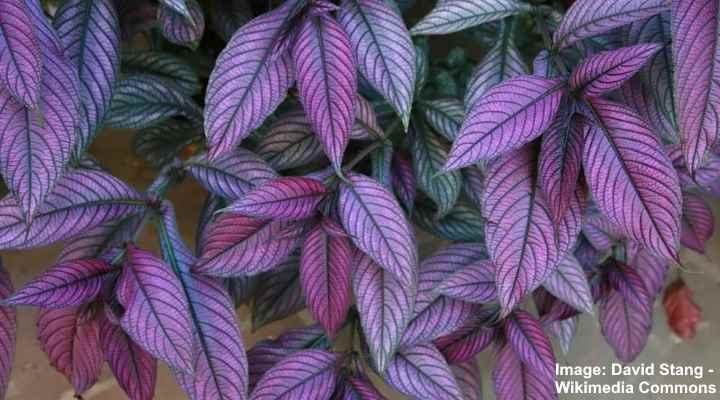
Persian shield is a type of ornamental evergreen shrub with purple leaves suitable for warm climate
Persian shield is a great type of a striking purple bush for landscaping as it is very hardy and requires very little care.
Persian shield is a dark-colored, beautiful shrub that is excellent for ground cover and it doesn’t lose its leaves in winter. However, for the plant to survive in your garden outdoors, you should live in warm climates.
The foliage on the Persian Shield can be in various shades of purple from lilac to deep purple. Some cultivars also have lance-shaped long leaves that have pointed tips.
- Growing zones: 9 or 10 or you can grow this indoor as a houseplant
- Size: 5 ft. (1.5 m), however, pruning can help keep the plant height down
- Conditions: Full sun and warm conditions. Requires organically rich, well-drained soil.
- Difficulty: A spreading plant that is easy to grow.
Heavenly Bamboo (Nandina domestica)
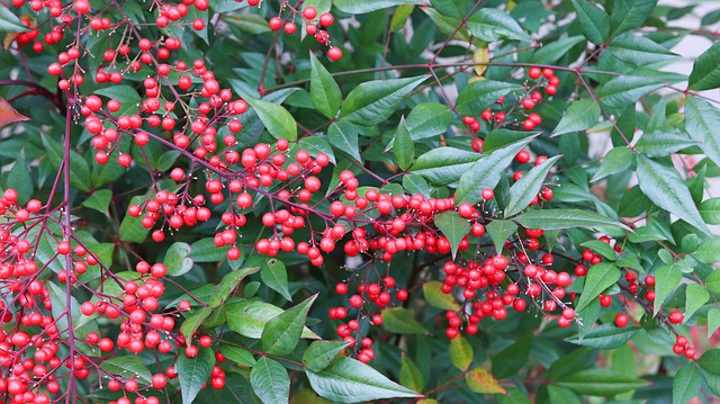
Nandina domestica (heavenly bamboo) shrub has red berries and summer green foliage before turning red in autumn
Heavenly bamboo is a small, slow-growing shrub with lots of landscaping appeal. The semi-evergreen nandina shrub bursts into spring colors with tiny white flowers before giving way to masses of bright red berries in fall and winter. The shrub’s bushy foliage of lance-shaped leaves emerges purple, turns green, and then changes to reddish-purple in the fall.
Heavenly bamboo grows 4 to 8 ft. (1.4 – 2.4) tall and up to 4 ft. (1.2 m) wide. The landscaping plant is ideal for growing as an informal hedge, foundation planting, woodland garden, or shrub border.
- Growing zones: 6 to 9
- Size: 4 to 8 ft. (1.4 – 2.4) tall and 2 to 4 ft. (0.6 – 1.2 m) wide
- Conditions: full sun to shade. Heavenly bamboo shrubs can grow in a range of soil types, but the shrubs prefer moist, well-drained, fertile soil.
- Difficulty: High maintenance to remove suckers
American Beautyberry (Callicarpa americana)

American beautyberry is a small ornamental shrub with attractive purple berries
American beautyberry is a stunning landscaping shrub for subtropical climates. The breath-taking feature of this deciduous shrub is its clusters of small, round magenta berries growing on arching stems. In addition, the elegant, colorful shrub has small pink, violet, or white spring flowers and large, fuzzy, light green leaves that turn yellow in the fall.
Also called French mulberry, the American beautyberry shrub is fast-growing with a loose, open habit. The easy-to-grow shrub matures at 3 to 6 ft. (1 – 1.8 m) tall, is drought-tolerant, and requires little maintenance. The shrub looks best at the back of the border in a backyard landscape.
- Growing zones: 6 – 11
- Size: 3 to 6 ft. (1 – 1.8 m) tall and wide
- Conditions: Full sun or partial sun
- Difficulty: Low maintenance, easy
Related articles:
- Small or Dwarf Evergreen Shrubs
- Small or Dwarf Flowering Shrubs
- Purple Flowering Shrubs
- White Flowering Shrubs


